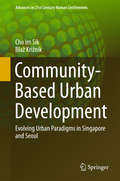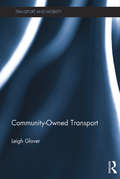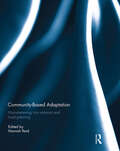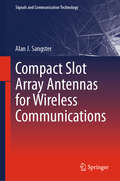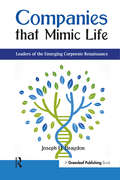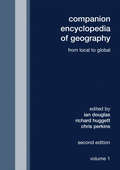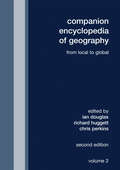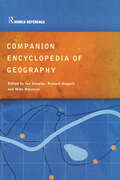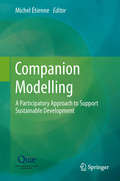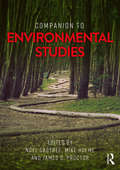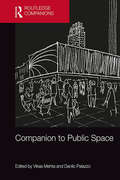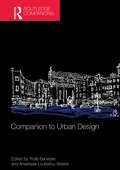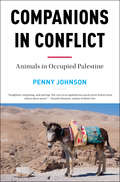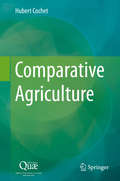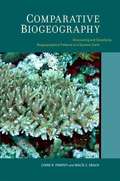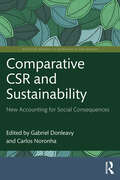- Table View
- List View
Community-Based Urban Development: Evolving Urban Paradigms in Singapore and Seoul (Advances in 21st Century Human Settlements)
by Im Sik Cho Blaž KrižnikThe book compares different approaches to urban development in Singapore and Seoul over the past decades, by focusing on community participation in the transformation of neighbourhoods and its impact on the built environment and communal life. Singapore and Seoul are known for their rapid economic growth and urbanisation under a strong control of developmental state in the past. However, these cities are at a critical crossroads of societal transformation, where participatory and community-based urban development is gaining importance. This new approach can be seen as a result of a changing relationship between the state and civil society, where an emerging partnership between both aims to overcome the limitations of earlier urban development. The book draws attention to the possibilities and challenges that these cities face while moving towards a more inclusive and socially sustainable post-developmental urbanisation. By applying a comparative perspective to understand the evolving urban paradigms in Singapore and Seoul, this unique and timely book offers insights for scholars, professionals and students interested in contemporary Asian urbanisation and its future trajectories.
Community-Owned Transport (Transport and Mobility)
by Leigh GloverCity and state governments around the world are struggling to achieve environmentally sustainable transport. Economic, technological, city and transport planning and human behaviour solutions are often hampered by ineffective implementation. So attention is now turning to institutional, governmental and political barriers. Approaches to these implementation problems assume that transport ownership can only be public (owned by state entities) or private (corporate or personal). Another option – largely unexplored to date – is communal ownership of transport.Community-Owned Transport proposes and develops the notion that communal ownership has a historical basis and provides unique opportunities for providing personal mobility. It looks at the historical roots of modern urban transport’s failings as those of technological change and the associated governing of transport systems, particularly the role of public sector institutions. Community ownership is explored through the new ‘sharing economy’ developments – car sharing, ridesharing and bicycle share schemes – and older social innovations in ecovillages and communal living. Models and practices of community ownership of transport are provided and this study also discusses how community ownership might contribute to sustainable transport.Drawing widely on different disciplines and fields of scholarship, this book explores the conceptual and practical aspects of communal ownership of transport. It will be a valuable resource for those seeking innovative approaches to addressing the pressing problems of transport, including graduate and postgraduate students, as well as policymakers, practitioners and community groups.
Community-based adaptation: Mainstreaming into national and local planning
by Hannah ReidCommunity-based adaptation (CBA) to climate change is based on local priorities, needs, knowledge and capacities. Early CBA initiatives were generally implemented by non-government organisations (NGOs), and operated primarily at the local level. Many used ‘bottom-up’ participatory processes to identify the climate change problem and appropriate responses. Small localised stand-alone initiatives are insufficient to address the scale of challenges climate change will bring, however. The causes of vulnerability - such as market or service access, or good governance - also often operate beyond the project level. Larger organisations and national governments have therefore started to implement broader CBA programmes, which provide opportunities to scale up responses and integrate CBA into higher levels of policy and planning. This book shows that it is possible for CBA to remain centred on local priorities, but not necessarily limited to work implemented at the local level. Some chapters address the issue of mainstreaming CBA into government policy and planning processes or into city or sectoral level plans (e.g. on agriculture). Others look at how gender and children’s issues should be mainstreamed into adaptation planning itself, and others describe how tools can be applied, and finance delivered for effective mainstreaming.This book was published as a special issue of Climate and Development.
Commutation Relations, Normal Ordering, and Stirling Numbers
by Toufik Mansour Matthias SchorkCommutation Relations, Normal Ordering, and Stirling Numbers provides an introduction to the combinatorial aspects of normal ordering in the Weyl algebra and some of its close relatives. The Weyl algebra is the algebra generated by two letters U and V subject to the commutation relation UV - VU = I. It is a classical result that normal ordering pow
Compact Slot Array Antennas for Wireless Communications (Signals and Communication Technology)
by Alan J. SangsterThis book describes and provides design guidelines for antennas that achieve compactness by using the slot radiator as the fundamental building block within a periodic array, rather than a phased array. It provides the basic electromagnetic tools required to design and analyse these novel antennas, with sample calculations where relevant. The book presents a focused introduction and valuable insights into the relevant antenna technology, together with an overview of the main directions in the evolving technology of compact planar arrays. While the book discusses the historical evolution of compact array antennas, its main focus is on summarising the extensive body of literature on compact antennas. With regard to the now ubiquitous slot radiator, it seeks to demonstrate how, despite significant antenna size reductions that at times even seem to defy the laws of physics, desirable radiation pattern properties can be preserved. This is supported by an examination of recent advances in frequency selective surfaces and in metamaterials, which can, if handled correctly, be used to facilitate physics-defying designs. The book offers a valuable source of information for communication systems and antenna design engineers, especially thanks to its overview of trends in compact planar arrays, yet will also be of interest to students and researchers, as it provides a focused introduction and insights into this highly relevant antenna technology.
Companies that Mimic Life: Leaders of the Emerging Corporate Renaissance
by Joseph H. BragdonIndustrial capitalism is broken. The signs, which transcend national ideologies, are everywhere: climate change; ecological overshoot; financial exhaustion; fraying social safety nets; corporate fraud; government deceit; civic unrest; terrorism; and war. But there is hope. This book tells how transformation is taking root in the corporate world – the last place many of us would look for solutions. The book tells the stories of seven exceptional companies. Their shared secret is a new mental model of the firm that is the virtual opposite of industrial capitalism. Each company, if not already a household name, is a significant player within their industry and, crucially, has outperformed their competitors. Lessons can be learned. It works like this. Instead of modeling themselves on the assumed efficiency of machines – a thought process that emerged during the industrial age – these firms model themselves on living systems. Firms with open, ethical, inclusive traditions – where employees have a voice and a stake in what happens – have a distinct advantage over traditionally managed companies where most decisions are made at the top. Understanding that everything of value ultimately arises from life, they place a higher value on living assets (people and Nature) than they do on non-living capital assets. The energy they invest in stewarding those assets – a practice described in the book as living asset stewardship (LAS) – is transformative.
Companion Encyclopedia of Geography: From the Local to the Global
by Ian Douglas Chris Perkins Richard HuggettThis revised edition takes the theme of place as the unifying principle for a full account of the discipline at the beginning of the twenty-first century.The work comprises sixty-four substantial essays addressing human and physical geography, and exploring their inter-relations. The Encyclopedia does full justice to the enormous growth of social and cultural geography in recent years. Leading international academics from ten countries and four continents have contributed, ensuring that differing traditions in geography around the world are represented. In addition to references, the essays also have recommendations for further reading. As with the original work, the new Companion Encyclopedia of Geography provides a state-of-the-art survey of the discipline and is an indispensable addition to the reference shelves of libraries supporting research and teaching in geography.
Companion Encyclopedia of Geography: From the Local to the Global
by Ian Douglas Chris Perkins Richard HuggettThis revised edition takes the theme of place as the unifying principle for a full account of the discipline at the beginning of the twenty-first century.The work comprises 64 substantial essays addressing human and physical geography, and exploring their inter-relations. The encyclopedia does full justice to the enormous growth of social and cultural geography in recent years. Leading international academics from ten countries and four continents have contributed, ensuring that differing traditions in geography around the world are represented. In addition to references, the essays also have recommendations for further reading. As with the original work, the new Companion Encyclopedia of Geography provides a state-of-the-art survey of the discipline and is an indispensable addition to the reference shelves of libraries supporting research and teaching in geography.
Companion Encyclopedia of Geography: The Environment and Humankind
by Ian Douglas Mike Robinson Prof Ian Douglas Richard John HuggetThe Companion Encyclopedia of Geography provides an authoritative and provocative source of reference for all those concerned with the earth and its people. Examining both physical and human geography and charting human activities within their habitat up to the present day, this Companion also asks what lies in the future:* A differentiated world* A world transformed by the growth of a global economy* The global scale of habitat modification* A world of questions* Changing worlds, changing geographies* Geographical futures.The forty-five self contained chapters are bound into a unifying whole by the editors' general and part introductions; each chapter provides details of the most useful sources of further reading and research, and the volume is concluded with a comprehensive index. This is an invaluable resource not only for students, teachers and researchers in the academic domain but also professionals in interested commercial and public-sector organisations.
Companion Modelling: A Participatory Approach to Support Sustainable Development
by Michel ÉtienneThis book introduces the companion modelling approach by presenting the stance that underpins it, the methods and tools used with stakeholders and the specific role of models during the process. It addresses the means to deal with the different levels of decision-making and to take into account the various power relationships. It proposes a methodology to assess the impact of the approach on the stakeholders involved in the process. The book includes 27 case studies and 7 teaching tools that describe the successful use of the approach in a variety of settings or teaching contexts. It is intended for researchers working on rural development or renewable resources management, as well as students and teachers.
Companion to Environmental Studies
by Mike Hulme Noel Castree James D. ProctorCompanion to Environmental Studies presents a comprehensive and interdisciplinary overview of the key issues, debates, concepts, approaches and questions that together define environmental studies today. The intellectually wide-ranging volume covers approaches in environmental science all the way through to humanistic and post-natural perspectives on the biophysical world. Though many academic disciplines have incorporated studying the environment as part of their curriculum, only in recent years has it become central to the social sciences and humanities rather than mainly the geosciences. ‘The environment’ is now a keyword in everything from fisheries science to international relations to philosophical ethics to cultural studies. The Companion brings these subject areas, and their distinctive perspectives and contributions, together in one accessible volume. Over 150 short chapters written by leading international experts provide concise, authoritative and easy-to-use summaries of all the major and emerging topics dominating the field, while the seven part introductions situate and provide context for section entries. A gateway to deeper understanding is provided via further reading and links to online resources. Companion to Environmental Studies offers an essential one-stop reference to university students, academics, policy makers and others keenly interested in ‘the environmental question’, the answer to which will define the coming century.
Companion to Public Space
by Vikas MehtaThe Companion to Public Space draws together an outstanding multidisciplinary collection of specially commissioned chapters that offer the state of the art in the intellectual discourse, scholarship, research, and principles of understanding in the construction of public space. Thematically, the volume crosses disciplinary boundaries and traverses territories to address the philosophical, political, legal, planning, design, and management issues in the social construction of public space. The Companion uniquely assembles important voices from diverse fields of philosophy, political science, geography, anthropology, sociology, urban design and planning, architecture, art, and many more, under one cover. It addresses the complete ecology of the topic to expose the interrelated issues, challenges, and opportunities of public space in the twenty-first century. The book is primarily intended for scholars and graduate students for whom it will provide an invaluable and up-to-date guide to current thinking across the range of disciplines that converge in the study of public space. The Companion will also be of use to practitioners and public officials who deal with the planning, design, and management of public spaces.
Companion to Urban Design
by Tridib Banerjee Anastasia Loukaitou-SiderisToday the practice of urban design has forged a distinctive identity with applications at many different scales – ranging from the block or street scale to the scale of metropolitan and regional landscapes. Urban design interfaces many aspects of contemporary public policy – multiculturalism, healthy cities, environmental justice, economic development, climate change, energy conservations, protection of natural environments, sustainable development, community liveability, and the like. The field now comprises a core body of knowledge that enfolds a right history of ideas, paradigms, principles, tools, research and applications, enriched by electric influences from the humanities, and social and natural sciences. Companion to Urban Design includes more than fifty original contributions from internationally recognized authorities in the field. These contributions address the following questions: What are the important ideas that have shaped the field and the current practice of urban design? What are the major methods and processes that have influenced the practice of urban design at various scales? What are the current innovations relevant to the pedagogy of urban design? What are the lingering debates, conflicts ad contradictions in the theory and practice of urban design? How could urban design respond to the contemporary challenges of climate change, sustainability, active living initiatives, globalization, and the like? What are the significant disciplinary influences on the theory, research and practice of urban design in recent times? There has never before been a more authoritative and comprehensive companion that includes core, foundational and pioneering ideas and concepts of urban design. This book serves as an invaluable guide for undergraduate and postgraduate students, future professionals, and practitioners interested in architecture, landscape architecture, and urban planning, but also in urban studies, urban affairs, geography, and related fields.
Companions in Conflict: Animals in Occupied Palestine
by Penny JohnsonAn award-winning author explores the Israeli-Palestinian conflict through a surprising lens: the animals trying to survive in occupied hotspotsIn August of 2016, Israeli police officers arrested a Palestinian donkey in the Jordan Valley. The charge? Not having the correct paperwork.It's an image as sad (and strangely common) as it is symbolic: No creature great or small is free from the absurdities of the Occupied Territories. Companions in Conflict is a surprising investigation into the deeply intertwined lives of the region's human and animal populations: From camel beauty contests, to a herd of "illegal" Palestinian cows hunted down by Israeli soldiers; from a hyena in a wolf pack that becomes a symbol of Middle East peace, to the tragic story of the now-taxidermied inhabitants of the West Bank's only zoo--who were frightened to death by Israeli explosive devices. Drawing on three decades of living in the region, Penny Johnson's insightful writing reveals what these and many other animals' fates tell us about the current state of Israel and Palestine. What's more, looking forward, she introduces a new generation of environmental activists to us, who represent the region's best hope for conservation, collaboration, and justice for all creatures.
Company Law and Sustainability
by Sjåfjell, Beate and Richardson, Benjamin J. Beate Sjåfjell Benjamin J. RichardsonThis investigation of the barriers to and opportunities for promoting environmental sustainability in company law provides an in-depth comparative analysis of company law regimes across the world. The social norm of shareholder primacy is the greatest barrier preventing progress, and it also helps explain why voluntary action by companies and investors is insufficient. By deconstructing the myth that shareholder primacy has a legal basis and challenging the economic postulates on which mainstream corporate governance debate is based, Company Law and Sustainability reveals a surprisingly large unexplored potential within current company law regimes for companies to reorient themselves towards sustainability. It also suggests possible methods of reforming the existing legal infrastructure for companies and provides an important contribution to the broader debate on how to achieve sustainability.
Comparative Agriculture
by Hubert CochetIn the first section dedicated to theoretical thoughts on comparative agriculture, Hubert Cochet introduces the notion of "agricultural development", the very subject of comparative agriculture, with a restored endogenous dimension. He then describes how this approach was slowly consolidated, around the concept of agrarian system in particular. The comparison of agricultural transformations in time and space highlights the importance of the comparatist approach to production processes, their trajectories and differentiation on a worldwide scale. The second section which focuses on the methods and expertise of comparative agriculture, tackles the issues of landscape analysis, field surveys and the historical approach underlying comparative agriculture. It sums up the economic tools mobilised as well as the evaluation perspectives opened up by comparative agriculture.
Comparative Biogeography: Discovering and Classifying Biogeographical Patterns of a Dynamic Earth
by Lynne R. Parenti Malte C. EbachTo unravel the complex shared history of the Earth and its life forms, biogeographers analyze patterns of biodiversity, species distribution, and geological history. So far, the field of biogeography has been fragmented into divergent systematic and evolutionary approaches, with no overarching or unifying research theme or method. In this text, Lynne Parenti and Malte Ebach address this discord and outline comparative tools to unify biogeography. Rooted in phylogenetic systematics, this comparative biogeographic approach offers a comprehensive empirical framework for discovering and deciphering the patterns and processes of the distribution of life on Earth. The authors cover biogeography from its fundamental ideas to the most effective ways to implement them. Real-life examples illustrate concepts and problems, including the first comparative biogeographical analysis of the Indo-West Pacific, an introduction to biogeographical concepts rooted in the earth sciences, and the integration of phylogeny, evolution and earth history.
Comparative CSR and Sustainability: New Accounting for Social Consequences (Routledge Research in Sustainability and Business)
by Gabriel Donleavy and Carlos NoronhaThis book breaks new ground by providing a structured and cohesive set of contributions on the actions, developments, problems and theories of corporate social responsibility (CSR). With new case studies from the UN’s Least Developed Countries (LDCs), contributors in this book investigate how firms in Eastern and Western countries are responding to and making use of evolving CSR guidelines. The book addresses the following questions: is CSR simply greenwashing or an authentic commitment to responsible corporate citizenship? Has globalization drawn CSR conduct in LDCs closer to that of industrialized countries? Stakeholder theory, actor–network theory and a new orbital theory of accountability are applied to give coherence to the case studies. Other chapters address greenwashing in reports, the impact of CSR in socially stigmatized occupations, an analysis on what responsibility precisely entails in CSR, and the interface between law and CSR. The book also considers the impact of COVID-19 on the hospitality industry, and includes a contribution from Ukrainian scholars, one written while their city of Kharkiv was under attack by Russian forces. This book will be a useful reference to those interested in discussions on crises, climate change, and SDGs and realizing sustainable goals through CSR.
Comparative Plant Succession among Terrestrial Biomes of the World (Ecology, Biodiversity and Conservation)
by Lawrence R. Walker Karel PrachDespite a century of study by ecologists, recovery following disturbances (succession) is not fully understood. This book provides the first global synthesis that compares plant succession in all major terrestrial biomes and after all major terrestrial disturbances. It asks critical questions such as: Does succession follow general patterns across biomes and disturbance types? Do factors that control succession differ from biome to biome? If common drivers exist, what are they? Are they abiotic or biotic, or both? The authors provide insights on broad, generalizable patterns that go beyond site-specific studies, and present discussions on factors such as varying temporal dynamics, latitudinal differences, human-caused vs. natural disturbances, and the role of invasive alien species. This book is a must-read for researchers and students in ecology, plant ecology, restoration ecology and conservation biology. It also provides a valuable framework to aid land managers attempting to manipulate successional recovery following increasingly intense and widespread human-made disturbances.
Comparing Futures for the Sacramento-San Joaquin Delta
by Jay R. Lund Ellen Hanak William E. Fleenor William A. Bennett Richard E. Howitt Jeffrey F. Mount Peter B. MoyleWritten by a team of independent water experts, this analysis of the latest data evaluates proposed solutions to the Sacramento-San Joaquin Delta's myriad problems. The authors find the current policy unsustainable and suggest a suitable strategy.
Comparing Rural Development: Continuity and Change in the Countryside of Western Europe (Perspectives on Rural Policy and Planning)
by Mark Shucksmith Arnar ÁrnasonAt a time when there is major reorientation of rural economies in Europe, and the emergence of new possibilities both for governance and for conflict, this book brings together a group of leading academics in the fields of geography, sociology and anthropology to examine how such changes are taking place in the west of Europe. It describes, analyses and theorises the role of networks and social capital in rural development in six countries: Finland, Ireland, Italy, Norway, Scotland and Sweden, and addresses the tension between studying 'local' rural development and the 'globalized' nature of modern economies and societies. An approach to networks and social capital is used as a way of drawing attention to the non-economic dimensions of rural development and society. The book stresses that the links between society and economics are of key importance.
Compass and Gyroscope: Integrating Science And Politics For The Environment
by Philip Shabecoff Kai N. LeeUsing the Columbia River Basin in the Pacific Northwest as a case study, Kai Lee describes the concept and practice of "adaptive management," as he examines the successes and failures of past and present management experiences. Throughout the book, the author delves deeply into the theoretical framework behind the real-world experience, exploring how theories of science, politics, and cognitive psychology can be integrated into environmental management plans to increase their effectiveness.
Compass: A Story of Exploration and Innovation
by Alan Gurney"The compass' rocky evolution is charted with an enthusiast's passion....A fascinating adventure."--Bernadette Murphy, Los Angeles Times Compass chronicles the misadventures of those who attempted to perfect the magnetic compass--so precious to sixteenth-century seamen that, by law, any man found tampering with it had his hand pinned to the mast with a dagger. From the time man first took to the seas until only one thousand years ago, sight and winds were the sailor's only navigational aids. It was not until the development of the compass that maps and charts could be used with any accuracy--even so, it would be hundreds of years and thousands of shipwrecks before the marvelous instrument was perfected. And its history up to modern times is filled with the stories of disasters that befell sailors who misused it. In this page-turning history of man's search for reliable navigation of treacherous sea routes around the globe, Alan Gurney brings to life the instrument Victor Hugo called "the soul of the ship."
Compatible Solutes Engineering for Crop Plants Facing Climate Change
by Shabir Hussain Wani Manu Pratap Gangola Bharathi Raja RamadossPlants, being sessile and autotrophic in nature, must cope with challenging environmental aberrations and therefore have evolved various responsive or defensive mechanisms including stress sensing mechanisms, antioxidant system, signaling pathways, secondary metabolites biosynthesis, and other defensive pathways among which accumulation of osmolytes or osmo-protectants is an important phenomenon. Osmolytes with organic chemical nature termed as compatible solutes are highly soluble compounds with no net charge at physiological pH and nontoxic at higher concentrations to plant cells. Compatible solutes in plants involve compounds like proline, glycine betaine, polyamines, trehalose, raffinose family oligosaccharides, fructans, gamma aminobutyric acid (GABA), and sugar alcohols playing structural, physiological, biochemical, and signaling roles during normal plant growth and development. The current and sustaining problems of climate change and increasing world population has challenged global food security. To feed more than 9 billion, the estimated population by 2050, the yield of major crops needs to be increased 1.1–1.3% per year, which is mainly restricted by the yield ceiling. A major factor limiting the crop yield is the changing global environmental conditions which includes drought, salinity and extreme temperatures and are responsible for a reduction of crop yield in almost all the crop plants. This condition may worsen with a decrease in agricultural land or the loss of potential crop yields by 70%. Therefore, it is a challenging task for agricultural scientists to develop tolerant/resistant varieties against abiotic stresses. The development of stress tolerant plant varieties through conventional breeding is very slow due to complex multigene traits. Engineering compatible solutes biosynthesis by deciphering the mechanism behind the abiotic tolerance or accumulation in plants cell is a potential emerging strategy to mitigate adverse effects of abiotic stresses and increase global crop production. However, detailed information on compatible solutes, including their sensing/signaling, biosynthesis, regulatory components, underlying biochemical mechanisms, crosstalk with other signaling pathways, and transgenic development have not been compiled into a single resource. Our book intends to fill this unmet need, with insight from recent advances in compatible solutes research on agriculturally important crop plants.
Compendium of Urban Complexity (Understanding Complex Systems)
by Diego RybskiThis book brings together key findings, insights, and theories at the intersection of two disciplines – city science and complex systems. It features a curated collection of chapters contributed by emerging scholars conducting cutting-edge research in complexity science, interdisciplinary physics, and quantitative geography. The compendium is tailored to a thematically diverse audience, spanning quantitative fields such as statistical and mathematical physics, as well as socially-focused domains such as geography and urban planning. By integrating novel methods and insights from physics, economics, and geography, this book aims at an interdisciplinary spectrum of graduate students and academic researchers studying cities as complex systems.
